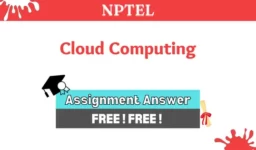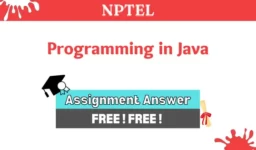
Get access to the solutions for Ethical Hacking NPTEL Assignment 1, solved successfully by me.
Boost your understanding of ethical hacking and improve your grades with these answers. Enhance your learning with these assignment solutions.
Ethical Hacking NPTEL Assignment 1 Answers
Q1. In which of the following penetration testing models, no information about the network is given to tester?
a. White box model.
b. Black box model.
c. Red box Model.
d. Gray box model.
e. None of these.
ANSWER: Option b
Over 1000 students have already discovered the power of instant notifications – don’t be the last to join in Telegram Channel.
Q2. Which of the following statement(s) is/are true for a circuit switched network?
a. A communication link can be shared by more than one connection.
b. A communication link is dedicated to a connection and cannot be shared with other connections.
c. The packet transfer delay between a pair of nodes may depend on the prevailing network traffic.
d. The packet transfer delay between a pair of nodes is more or less constant during the entire period of the connection.
e. It is efficient for bursty traffic.
ANSWER: Option b and d.
Q3. A packet of size 1000 bytes is sent over a 50 kilo-bits-per-second (Kbps) point-to-point link whose propagation delay is 10 msec. The packet will reach the destination after ________ msec. (Assume 1K = 1000)
ANSWER: 170
Explanation:
Here are the steps to calculate the time it takes for the packet to reach the destination:
- Convert the link’s bandwidth from Kbps to bps (bits per second) by multiplying it by 1000. In this case, 50 Kbps = 50 x 1000 = 50,000 bps
- Calculate the time it takes to transmit the packet by dividing the packet size (in bits) by the link’s bandwidth (in bps). In this case, the packet size is 1000 bytes = 8000 bits, so the transmission time is 8000 bits / 50,000 bps = 0.16 seconds = 160 milliseconds
- Add the link’s propagation delay to the transmission time. In this case, the propagation delay is 10 milliseconds, so the total time for the packet to reach the destination is 160 milliseconds + 10 milliseconds = 170 milliseconds
So the packet will reach the destination after 170 milliseconds.
Q4. Which of the following statement(s) is/are true for virtual circuit based packet transfer approach?
a. It is a connection-oriented approach, where a route is established priori to transfer of packets.
b. In this approach, each packets follows distinct path.
c. The intermediate node can perform dynamic routing.
d. All the packets reach in order to the destination.
e. It is a true packet switched network.
ANSWER: Option a and d.
Explanation:
In the virtual circuit-based packet transfer approach, a dedicated path or route is established prior to the transfer of packets, which is called a virtual circuit. This means that:
- It is a connection-oriented approach, where a route is established priori to transfer of packets.
- All the packets follow the same path of the virtual circuit and reach the destination in order.
It is not a true packet switched network as all the packets follows the same route established prior to the transfer, the intermediate node does not perform dynamic routing and it is not a true packet switched network.
Q5. Which of the following OSI layers is responsible for end-to-end reliable data transfer, with error recovery and flow control?
a. Session layer
b. Transport layer
c. Network layer
d. Datalink layer
e. Physical layer
ANSWER: b. Transport layer
Explanation:
The Transport layer (layer 4) of the OSI model is responsible for end-to-end reliable data transfer, with error recovery and flow control. It provides services to the upper layers of the OSI model by ensuring that data is delivered reliably and in the correct order to the receiving host. The transport layer also performs flow control to prevent overwhelming the receiving host with too much data and error recovery to ensure that data is not lost or corrupted during transmission. Examples of transport layer protocols include TCP and UDP.
Q6. Which of the following is/are false for TCP/IP model?
a. It allows cross-platform communications among heterogeneous networks.
b. It is a scalable client-server architecture which allows network modification without disrupting the current services.
c. It can also represent any other protocol stack other than the TCP/IP suite such as Bluetooth connection.
d. None of these.
ANSWER: Option c
Explanation:
- The TCP/IP model is specifically designed to provide a standardized method of communication between different types of networks and devices.
- It allows cross-platform communications among heterogeneous networks.
- It is a scalable client-server architecture which allows network modification without disrupting the current services.
Q7. Which of the following is true for the IP?
a. It uniquely identifies a network interface of a computer system.
b. It uniquely identifies a host in the network.
c. It indicates how many hardware ports are there in the computer system.
d. None of these.
ANSWER: b. It uniquely identifies a host in the network.
Q8. How many bits are used for IP address (in IP version 4) and port number respectively?
a. 32, 8
b. 32, 16
c. 48, 8
d. 48, 16
ANSWER: Option b
Q9. If a 2000 byte data message is sent using a TFTP, the corresponding Ethernet packet will be of size ________ bytes.
ANSWER: 2050
Q10. If the IP header is 192 bits long, what will be the value (in decimal) of the “HLEN” field ______________?
ANSWER: 6
Disclaimer: Just a heads up, these answers are only meant to help you as a reference. We can’t guarantee that they are 100% correct. It’s important for you to try completing the assignment on your own as well.
Also Available :




